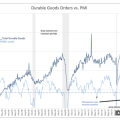November jobs report: signs of considerable strength, but warning signs of considerable weakness as well
– by New Deal democrat
Yesterday I wrote that “In tomorrow’s jobs report, my focus will be on whether the data is most consistent with a “soft landing,” i.e., no further deterioration, or whether deceleration has been continuing;” and more specifically:
- .My expectation, based on real consumer spending, is that there is likely to be further deceleration in jobs gains compared with the last 6 month average of 205,000,
- either a steady unemployment rate of 3.9% with a possible 0.1% increase to 4.0%.
- Based on the leading relationship of the quits rate to average hourly earnings, I expect YoY wage growth to remain steady at 4.4%, or to decline slightly further to 4.3%.
Two of the three came to pass. The six month average of jobs gained declined to 186,000, and average hourly wages for nonsupervisory workers declined to 4.3%. But the unemployment rate declined -0.2% to 3.7%
Here’s my in depth synopsis.
HEADLINES:
- 199,000 jobs added (169,000 ex-returning strikers). On a YoY basis, jobs are up 1.8%.
- September was revised further downward, by -29,000, while October remained unchanged. This continues the pattern of downward revisions that we have seen all year except for two months ago. The 3 month moving average remained at 204,000 The June-August average of 167,000 remains the low.
- Private sector jobs increased 150,000 (120,000 ex-strike). Government jobs increased by 49,000. Excluding the UAW strike, June-s 104,000 remains the low.
- The alternate, and more volatile measure in the household report, which declilned* by -348,000 in October, rebounded by 747,000 in November. The YoY% gain in this report is +2.2%.
- The U3 unemployment rate fell -0.2% to 3.7%. The civilian labor force, the denominator in the figure, rose (by 532,000), and the numerator, the number of unemployed, declined (by -215,000).
- The U6 underemployment rate declined -0.2% to 7.0% (still 0.5% above its low set in December 2022).
- Further out on the spectrum, those who are not in the labor force but want a job now declined -49,000 to 5.324 million, vs. its post-pandemic low of 4.925 million set this past March.
Leading employment indicators of a slowdown or recession
These are leading sectors for the economy overall, and help us gauge how much the post-pandemic employment boom is shading towards a downturn. These were mixed:
- the average manufacturing workweek, one of the 10 components of the Index of Leading Indicators, declined -0.1 hours to 40.6, equal to its lows earlier this year and down -0.9 hours from its February 2022 peak of 41.5 hours.
- Manufacturing jobs rose 28,000 (but declined -2,000 ex-strike).
- Within that sector, motor vehicle manufacturing jobs rose +30,000 (including the returning strikers).
- Construction jobs increased by 2,000.
- Residential construction jobs, which are even more leading, declined by -1,700. There had been a sharp rebound in the prior three months, but January remains the peak for this sector.
- Goods jobs as a whole rose 29,000 to a new expansion high (but were down -1,000 ex-returning strikers). These should decline before any recession occurs. They remain up 1.1% YoY,, which is an average pace compared with most of the last 40 years.
- Temporary jobs, which have generally been declining late last year, declined again, by -13,600, and are down about -240,000 since their peak in March 2022.
- the number of people unemployed for 5 weeks or fewer declined -200,000 to 2,068,000.
Wages of non-managerial workers
- Average Hourly Earnings for Production and Nonsupervisory Personnel increased $.12, or +0.4%, to $29.68, a YoY gain of +4.3%. This is the lowest since June 2021.
Aggregate hours and wages:
- the index of aggregate hours worked for non-managerial workers rose +0.4%, and is up 1.3% YoY, a sharp rebound from last month.
- the index of aggregate payrolls for non-managerial workers rose less than 0.9%, and is up 5.7% YoY, and increase of 0.5% from one month ago and a three month high. This is 2.5% above the most recent inflation rate, meaning average working class families have more buying power.
Other significant data:
- Leisure and hospitality jobs, which were the most hard-hit during the pandemic, rose 40,000, which is still -158,000, or -0.9% below their pre-pandemic peak.
- Within the leisure and hospitality sector, food and drink establishments rose 38,300, which is about 45,000 above their pre-pandemic peak.
- Professional and business employment declined -9,000. These tend to be well-paying jobs, With revisions, this series has been declining, by -46,000 since May, and is currently up 0.8% YoY, its lowest YoY gain since March 2021. For the entire 80+ year history of this series, any YoY gain this low only occurred during recessions.
- The employment population ratio rose 0.3% to 60.5%, vs. 61.1% in February 2020.
- The Labor Force Participation Rate rose 0.1% to 62.8%, vs. 63.4% in February 2020.
SUMMARY
This month’s report, like last month’s was affected by the UAW strike. But, as if often the case, the establishment report (which gives us job gains and losses in various sectors) and the household report (which gives us the un- and under-employment rates) told very different stories.
The household report was as excellent as last month’s report was bad. All of the losses in October were made up, or more, in November. More people entered the labor force, and more of them found jobs. Like weekly initial claims, short term unemployment declined (i.e., there were fewer layoffs), and there were fewer discouraged job-seekers.
But the establishment report contained some warnings. Once we back out returning strikers, manufacturing employment declined, as did residential construction, and more broadly goods producing jobs, as well as temporary employment. In other words, every sector that I would expect to roll over before a recession, with the exception of total construction employment, has now done so. Perhaps just as ominously, as noted above the decline in professional and business employment similar to the last 6 months over the entire 80+ year history of the series has only occurred at the onset of recessions.
On the other hand, aggregate hours and payrolls had big increases this month. Most importantly, until real, inflation-adjusted payrolls decline significantly, I would not expect any recession to begin.
In conclusion, this was a very mixed report, with some signs of considerable strength, and others of considerable weakness. There is no contraction – but there is no strong expansion either.
Scenes from the October jobs report: soft landing vs. continued slow deceleration, Angry Bear, New Deal democrat.



